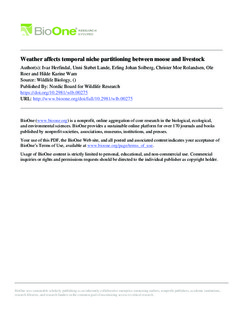| dc.description.abstract | Co-existing species at the same trophic level often segregate with respect to diet, habitat use, or spatial distribution, reducing their direct competition for resources. However, temporal patterns in species-specific habitat use, for instance due to climatic variation, may affect the strength of interspecific interactions, and generate temporal variation in niche partitioning. We assessed temporal variation in habitat overlap between a wild ungulate, moose Alces alces, and two freeranging domestic ungulates, sheep Ovis aries and cattle Bos taurus, on a boreal forest range in southern Norway. We also calculated the distance between species' realised niches, as well as the width of their realised niches to evaluate the extent of temporal niche partitioning under different diurnal weather conditions. Analyses of each habitat variable suggested complex relationships between species-specific habitat use, photoperiod, and weather, related to species-specific behaviour and activity patterns. We found shorter overall niche distance between moose and sheep, compared to moose and cattle, and shorter niche distances during day and night than during the twilight hours. The niche distance between moose and sheep was positively related to temperature during night, but negatively during day. Moreover, niche distance between moose and both sheep and cattle was negatively related to precipitation at daytime. Moose niche width was narrower in periods with short niche distance to sheep, while we did not find such pattern towards cattle. A lack of similar moose response to cattle could be attributed to lower niche overlap between moose and cattle. Our results suggest that temporal niche partitioning between moose and livestock breaks down under the weather conditions that are predicted to become more common as climate change, potentially increasing wildlife-livestock interactions in the future. | nb_NO |

